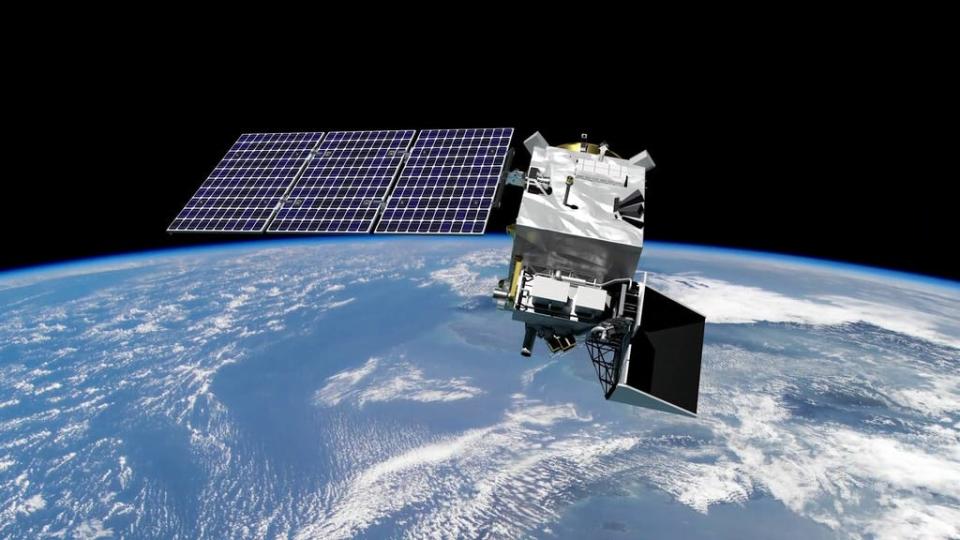Red tide, manatees and hurricanes: NASA PACE spacecraft to collect Florida environmental data
Algal bloom and red tide detection and prediction. The health of seagrass beds, a key food source for manatees. Coral reef bleaching. And even hurricane forecasting.
Florida's shallow-water coastlines may be environmentally analyzed in unprecedented detail via NASA's PACE spacecraft, which launched amid cloudy conditions at 1:33 a.m. EST Thursday atop a SpaceX Falcon 9 rocket from Cape Canaveral Space Force Station.
Armed with a hyperspectral imaging radiometer and two polarimeters, PACE is NASA's most advanced ocean-color-detecting mission to date, spokesperson Katherine Rohloff said during a Sunday press conference.
Of note to Floridians: NASA touts PACE as "the first mission to provide measurements that enable prediction of the 'boom-bust' cycle of fisheries, the appearance of harmful algae, and other factors that affect commercial and recreational industries."
Brian Barnes, a research associate in the Optical Oceanography Lab at the University of South Florida College of Marine Science, specializes in assessing and monitoring coastal systems using satellite-based sensors. He said PACE should help scientists track growth and decline of seagrass beds across the Sunshine State.
"It's very hard to go out in a boat and identify where exactly all of the seagrass is. You can do it using high-resolution satellites, but that's a very laborious and time-consuming process. With PACE, it's going to be going over essentially every day, taking a look down," Barnes said.

Algal blooms: Take a peek at NASA's PACE spacecraft, which will study climate change and ocean health
"Our goal with the data is to essentially be able to say, 'OK, this particular patch in this area is such-and-such percent seagrass and such-and-such percent sand.' When the satellite comes by the next day, or next year, and we notice that that percentage has changed, then we have some indication about the health of the seagrass overall," he said.
Barnes said PACE should measure seagrass in larger estuaries such as Florida Bay, Tampa Bay, Charlotte Harbor and Biscayne Bay, as well as Lake Okeechobee.
However, the spacecraft will not be as effective analyzing smaller estuaries such as the Indian River Lagoon, said Jeremy Werdell, a NASA PACE project scientist.
Barnes and fellow researchers are developing sets of algorithms to translate PACE data, which will be open-source and available to the public, to monitor ocean health — "this is not just monitoring for Florida, this is global." Other data sets will include various species of phytoplankton, which trigger red tide and algal blooms, and sargassum seaweed.

Patrick Rose, executive director of the Longwood-based Save the Manatee Club, said he looks forward to PACE's observations of seagrass beds and harmful algal blooms.
"I'm definitely going to follow this a little closer. We've seen what they've been able to do with the Webb telescope from a more nebulous standpoint — a little pun for you. But it's good to see these newer systems taking a closer look at the Earth," Rose said.
"It's going to be important to have earlier warnings, too," he said.
Worst coral bleaching summer ever recorded

Barnes said PACE data should also help researchers monitor the health of coral reefs.
"They're in the same type of environments (as seagrass). They generally can be seen from space. And they could also have similar types of changes in their distribution, their fractional coverage of coral relative to other algae and so forth," Barnes said.
"Corals can change as well. And coral bleaching is something that we could pick up with PACE. Because we have a dark coral, and for coral bleaching it becomes very bright. And you can pick that up in the PACE data stream," he said.
Manatees: Report: As many as 11,730 manatees remain in Florida, despite famine from seagrass loss
Last summer, amid hotter waters during El Ni?o climatic conditions, Florida's coral reef endured the worst bleaching event ever recorded, the Florida Fish and Wildlife Conservation Commission reported. Bleaching occurs when coral expels zooxanthellae, a microscopic algae, stressing the coral's health.
Sunshine State corals in the Dry Tortugas, Marquesas, Florida Keys and southern Miami-Dade County were most heavily impacted last summer, the FWC reported, while northern coral off Broward, Palm Beach and Martin counties were impacted less.
Hurricane predictions involving African dust
PACE's instruments will also detect airborne particles and aerosols, ranging from wildfire smoke and volcanic eruptions to the carbon exchange between oceans and the atmosphere.
The spacecraft could also improve hurricane forecasting by detecting dust blowing westward off the Sahara Desert in Africa, said Karen St. Germain, director of NASA's Earth Science Division.
How? "The warmth, dryness, and strong winds associated with the Saharan Air Layer have been shown to suppress tropical cyclone (hurricane) formation and intensification," NOAA reports.
During a Monday prelaunch news conference, St. Germain said NOAA — which operates the National Hurricane Center in Miami — is a principal partner in the PACE mission.
"We expect the data coming from PACE to be a very important improvement in our understanding of how that process happens, and improving the predictive models that predict hurricane intensification and track," St. Germain said of Saharan dust.

For the latest news from Cape Canaveral Space Force Station and NASA's Kennedy Space Center, visit floridatoday.com/space.
Rick Neale is a Space Reporter at FLORIDA TODAY (for more of his stories, click here.) Contact Neale at 321-242-3638 or [email protected]. Twitter/X: @RickNeale1
This article originally appeared on Florida Today: NASA PACE to collect Florida data on red tide, seagrass and hurricanes
